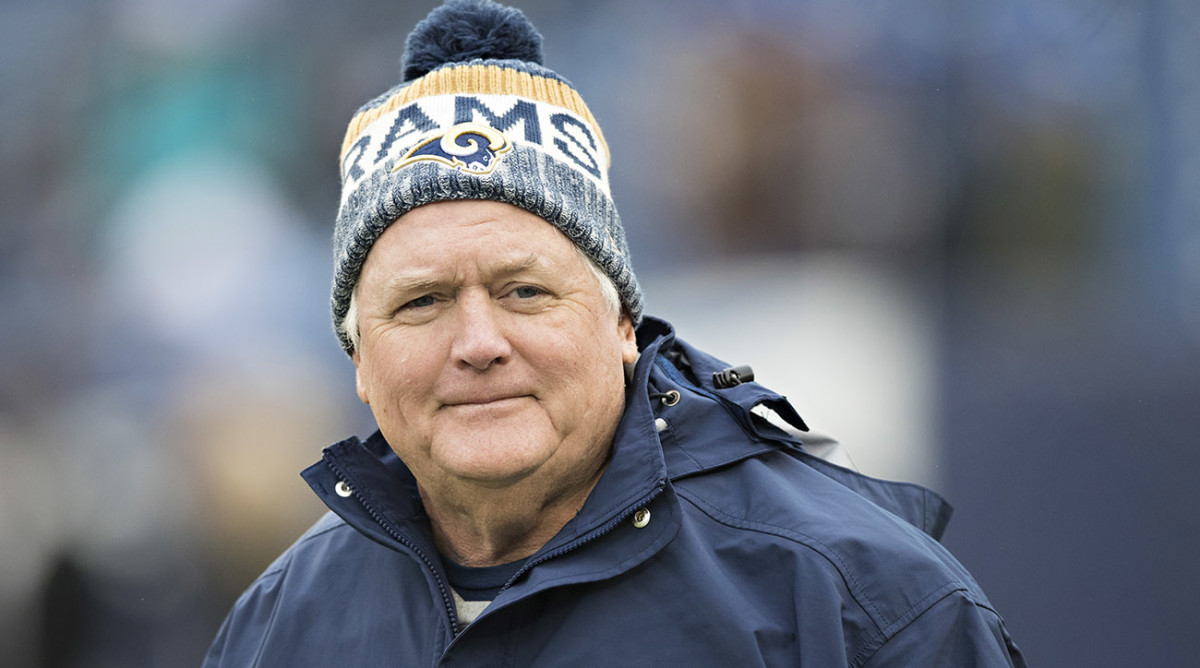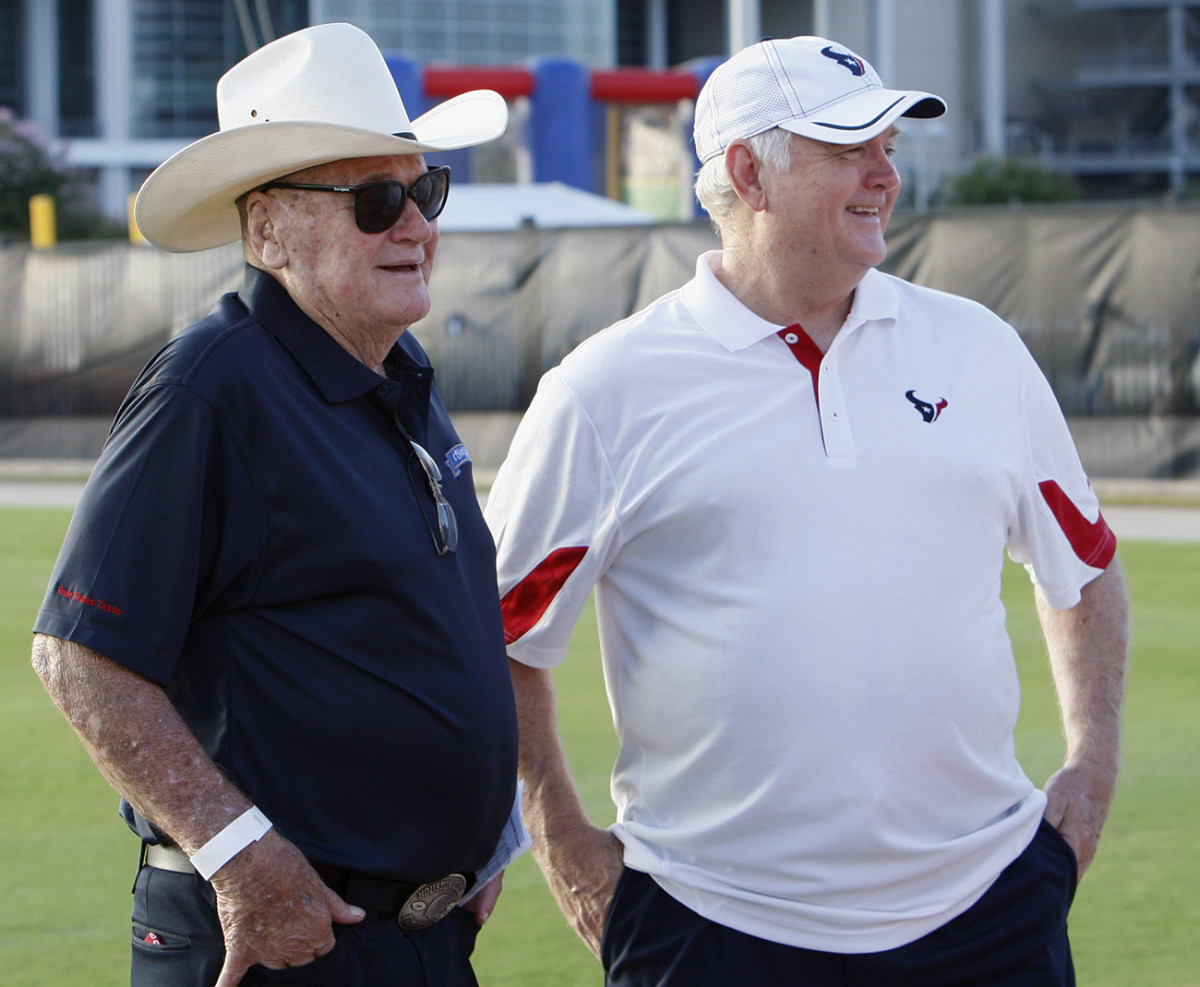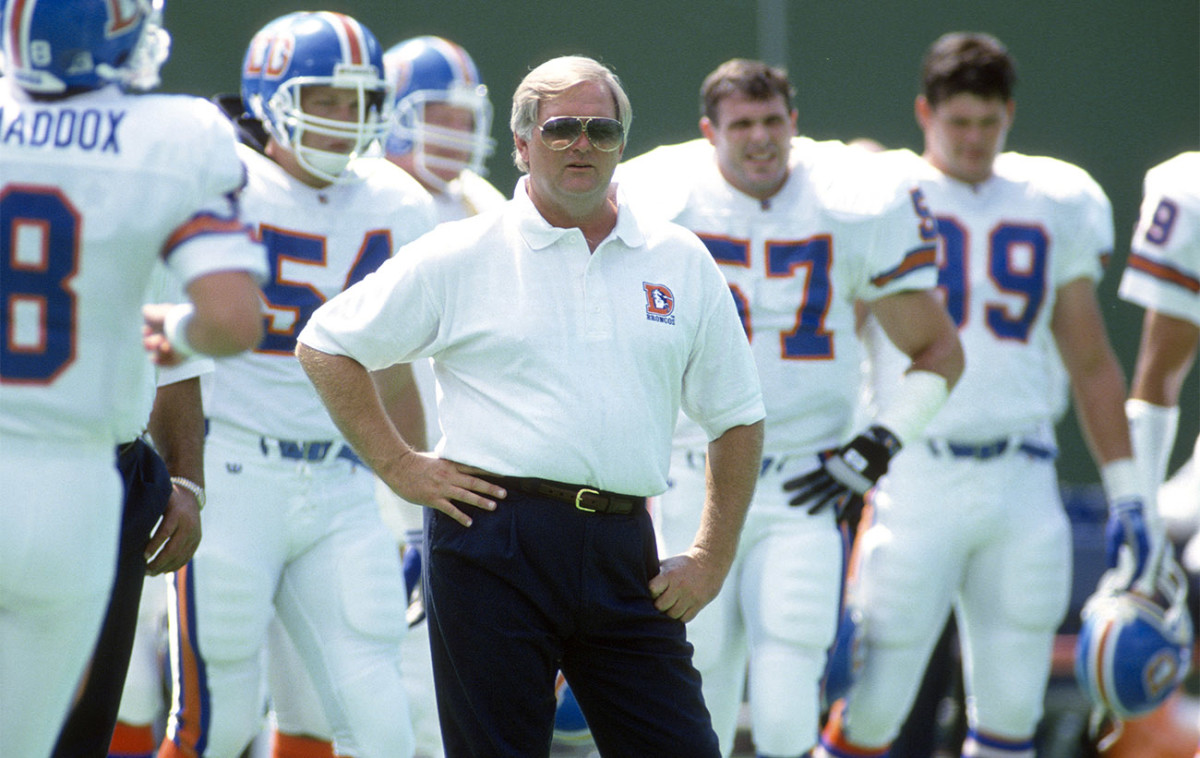The Wade Phillips Experience

You’re forgiven if you don’t think of defense when you think about the Rams’ late-November win over the Chiefs. Fourteen touchdowns and 105 points were scored that night, though that included three defensive scores—including this one, just inside the two-minute warning of the first half.
Aaron Donald was lined up against left guard Cam Erving, and the reigning Defensive Player of the Year used a stutter step to get around Erving’s outside shoulder. As Donald closed in on Patrick Mahomes, he extended his right arm to bat the football out of the QB’s hand. It dropped to the grass, bouncing around just outside the Chiefs’ 10-yard line. That’s when Samson Ebukam emerged, peeling off his blocker to make a beeline for the loose ball, scoop it, and sprint into the end zone. Watching this unfold from the sideline, Rams cornerback Nickell Robey-Coleman had one thought, That was all pursuit drill.
Pursuit drill is a favorite of Wade Phillips for reasons that—like the Rams’ defensive coordinator himself—date back several decades. In 1976, Phillips was working his first NFL gig, as the linebackers coach on his dad’s Houston Oilers staff. One of his players was Robert Brazile, the first-round pick who always seemed to be wherever the action was on the field. One day, Phillips asked him how he managed this. Brazile replied, “Coach, I practice that.”
It’s a story that Phillips’s Rams players can recite, because he tells it to them when explaining the pursuit drill. There are a few different versions of the drill; one involves giving the ball to the running back, then the defensive players chase him all the way down the sideline until they catch him. But they all involve running to the ball, like Ebukam did on that fumble recovery touchdown, and this lesson: It doesn’t take talent to give effort.
Brazile was a Hall of Famer, and when Phillips moved the next season to coach the Oilers’ defensive line, he worked with Curley Culp and Elvin Bethea, both of whom would also be fitted for gold jackets. “I thought I was a pretty good coach then,” Phillips says. “I didn’t realize those guys were just better than everybody.” His sense of humor is another thing that has been enduring.

Phillips has been calling defenses in professional football for nearly 40 years, which means he is able to recall a time when, if an opponent ran a motion on a offensive play once in a game, that was a big deal. Now offenses, including that of his own team, are running multiple motions on a single play.
In some ways, the 71-year-old, white-haired defensive coordinator with an age-stiffened gait is the counterbalance to all the things that we associate with the 2018 Rams, from their explosive offense to a 32-year-old head coach who is the proof of concept for the NFL’s youth movement. Phillips jokes that he’s coached for about every team in the NFL—in reality, the number is 10—from position coach to three stints as a head coach (six if you include interim stints). The message behind the Brazile story resonates with players, but in retelling it, a few temporarily blanked on the Hall of Famer’s name. Brazile retired after the 1984 season—not a single member of Phillips’s current unit was born before 1986.
But Phillips has a unique ability to be rooted in both the past and the present. How else would he, and his defense, be able to span eras? When he reported to training camp wearing a gray T-shirt printed with “Fortnite legend,” that was entirely in character, even if his only experience with the video game was watching his grandson play.
“Coach Phillips is just as young as we are,” rookie defensive end John Franklin-Myers, who turned 22 in September, says earnestly. Huh? He explains that he thought a coaching legend like Phillips would be stern and frightening. Instead he discovered a punster with a penchant for memes.
24 HOURS WITH SEAN MCVAY:A Day With the Rams Coach Before His First Season
When Phillips was the defensive coordinator in Denver, he made a point of learning the lyrics to popular songs, like Drake’s “Started From The Bottom,” surprising his players by being able to spit some rhymes. He joined Twitter nearly a decade ago, tapping out one-liners on his iPhone from his @sonofbum account. In April, he addressed the Rams’ flurry of personnel moves to his 173,000 followers: “You asked what’s Cookin’ with the Rams-they say we are getting too many star players. So Suh us!”
Other than receiver Brandin Cooks, the Rams’ big acquisitions were mostly on Phillips’s side of the ball: cornerbacks Aqib Talib and Marcus Peters, and defensive lineman Ndamukong Suh. Each had the potential to be key pieces for his defense, but all three had also been disciplined for on-field behavior on their previous teams. (Last month, Peters made headlines again for going up into the stands at the LA Coliseum to confront a fan during the Rams’ loss to the Eagles.)
Phillips didn’t need to make any kind of sell job to win over Peters. During their first conversation, after the Chiefs traded their former first-round draft pick, Peters says he called his new coach a “player,” a word not often applied to a septuagenarian.
“A player,” Peters clarifies, “is somebody that is chill, that is calm; in every situation, they are gonna be themselves. They’re not ever gonna get out of character.”
When they arrived at the Cal-Lutheran campus, about an hour north of L.A. for organized team activities, Peters says he began to “fall in love” with Phillips’s process of putting their defense together, beginning to understand how he’d gotten the most out of his players at his previous coaching stops.
“How enthused he was about teaching us football, how enthused he was to be able to work with us, to just be able to have a chance to get out and test the grass with us again,” Peters says. “You’ve got to appreciate a guy who appreciates going out there and just smelling grass. Even though we weren't getting ready to play for a game, he knew that were we were preparing for something that was gonna ultimately, in the long run, pay off.”

In the years before Bum Phillips died in 2013, he was a fixture at Texans practices. About 35 years after Bum hired his son to his Oilers staff, Wade was back in Houston, coordinating the Texans defense. Bum would come out to regular weekday practices, wearing his big bucket cowboy hat and watching from a golf cart.
“That was one of my favorite things about the NFL,” says Connor Barwin, the veteran Giants linebacker who played two seasons under Phillips in Houston and one more in Los Angeles. “To have his 80-something-year-old dad watching his son coach, who had already been coaching the NFL for 30, 40 years—I mean, Wade wasn’t young. But it was the coolest, loving thing I’d ever seen.”
Phillips wrote a book, “Son of Bum: Lessons My Dad Taught Me About Football and Life,” after his dominant defense helped the Broncos win Super Bowl 50. His dad taught him to be honest with his players, and Bum was also the root of his preference for the 3-4 base defense, which was good against the run and offered more ways to rush the passer. Since his first NFL gig on Bum’s Oilers staff, after a few years coaching in the high school and college ranks, Phillips has been collecting the principles he still practices today.
“In pro football, I started realizing that one nose guard was different than the other, and that you had to play to his strengths and how he played,” Phillips says. “They have a certain gap responsibility, but how they play it depends on the individual.”
FROM THE SI VAULT:‘Hallelujah. He's. Uh. Bum’ Curry Kirkpatrick on Bum Phillips (from the Oct. 27, 1980 issue)
During Phillips’s first stint with the Broncos, from 1989-94, as defensive coordinator then head coach, Greg Kragen was a small, quick nose guard whom they often used on stunts. In Buffalo, he played the 375-pound Ted Washington directly over the center, because he could overpower opponents. Suh is a powerful player who is also versatile enough to line up at nose tackle or defensive end, where he’s sometimes playing over a tight end, a big advantage for the Rams.
When players come to Phillips asking him if they can play something a different way, such as a rush technique or where they line up, he never says no—the answer is, “Yeah, if you can.” His rule is, if you’re good enough to freelance, you can go ahead. If not, you’ll do it his way. “That’s how he thinks, which is a great way to look at things,” Barwin says. “He’s been around so many great players, and he’s learned a lot from them. And that’s why he’s not shutting that down and saying, Lookit, DeMarcus Ware used to do this, so you need to do this. Well, then he had J.J. (Watt) or somebody, and they were like, Hey, can I do it this way? And Wade learned from them.”
Phillips recalls fielding questions when he was hired by the Rams about how Donald would transition from a 4-3 to a 3-4. “Well, he would fit in any defense,” Phillips says, with a chuckle. “But we try to put him in a position to make plays and do what he does, which is attack quickly.” Franklin-Myers, the rookie, was in the middle of describing some of the ways they do this through stunts—the end may pick off the guard, while Donald loops around the outside—when a veteran teammate poked his head out of the showers and told him not to give away their secrets.
KLEMKO:How Aaron Donald Is Redefining the Defensive Tackle Position in the NFL
The Rams have the best defensive player in the league, and were aggressive in acquiring new personnel all the way through the trade deadline, when they dealt for Dante Fowler, Jr. Still, the unit ended the regular season in the middle of the pack in yards and points allowed. Before each game, Phillips always gives his players the same message: “The mistakes are mine.” After that shootout with the Chiefs, the Rams had a bye week, giving Phillips time to make his own corrections.
Last year, Barwin recalls the Rams defense began to click when Phillips decided midseason to reimagine Michael Brockers, who had played nose tackle for the first five seasons of his NFL career, as a defensive end. This year, Phillips’s in-season adjustment was to call more zone coverage on the back end, hoping to better utilize Peters’s lateral quickness and ability to read routes after the cornerback got off to a bumpy start while also dealing with a calf injury; the secondary also benefitted from Talib’s return in early December from an ankle injury that landed him on short-term injured reserve.
“S---, everybody ain’t going to have an amazing year,” says Peters. “But all I know is how to be myself and rely on what got me here and that's me trusting and believing in my techniques and my instincts and making the plays when they happen. On the back end, that’s Wade just knowing, we may need to do something a tad different. I appreciate him. It doesn't just help just one person, it helps the overall defense, the mindset of, See ball, get ball.”
In the final five games of the regular season, the Rams took the ball away from their opponent 10 times. Besides points, Phillips quips, turnovers are the most important factor in winning a game.

Remember the run-and-shoot era? Phillips does. Specifically, he remembers a divisional round playoff game in January 1992 between the Broncos and Oilers. Phillips was in charge of Denver’s defense then, and they quickly fell behind, 14-0. Warren Moon passed for 325 yards and three touchdowns that day leading the Oilers’ run-and-shoot offense, and it wasn’t until Houston’s final possession that the Broncos forced them to punt. Denver escaped with a 26-24 victory after a dramatic game-winning march by John Elway, dubbed Drive II.
“For a while, that was the rage of the league and hard to stop,” Phillips says. Experience has taught him there’s always something that’s challenging to stop. Defense is about play recognition, and the more defenders see plays that were different from what they were used to seeing, like RPOs last year and the jet motions this year, the better they get at knowing what’s coming. In other words, now is the time for his defense to be peaking.
Make no mistake, the 2018 Rams defense is not the historic 2015 Broncos unit, which, in Super Bowl 50, stopped a Panthers team that had scored a total of 80 points in its first two playoff games.
Just one year later, though, Gary Kubiak retired as the Broncos head coach due to health issues, and Phillips was also replaced. It didn’t take long for McVay to ask him to be the yin to his yang in Los Angeles, the head coach in daycare paired with the defensive coordinator on Medicare, as Phillips famously joked on his Twitter account. Among the Rams’ eight wins to open this season was a 23-20 victory in Denver, after which McVay presented Phillips with a game ball. This is special, not because we beat the Broncos—because of you guys, Phillips told the team in the post-game locker room. I appreciate it. I love you guys.
“People always look at stats, and I look at them, too,” Phillips says. “Yeah, you want to be like we were at Denver when we won the Super Bowl. That was a special group. But I think we’ve got a special group here.”
There’s more than one way to play nose tackle, to build a defense, to win a championship. Football is always changing. But for four decades, Phillips has been a constant.
• Question or comment? Email us at talkback@themmqb.com.
